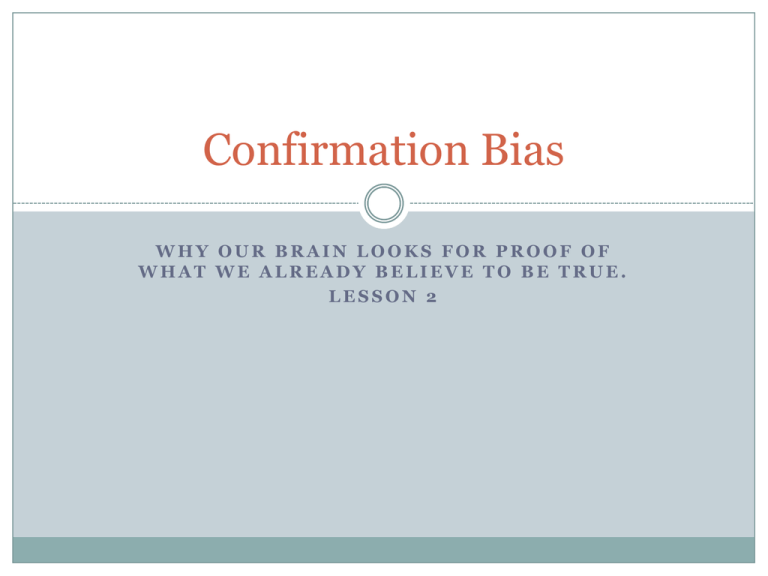Confirmation Bias
advertisement

Confirmation Bias WHY OUR BRAIN LOOKS FOR PROOF OF WHAT WE ALREADY BELIEVE TO BE TRUE. LESSON 2 Instructions for use of the Confirmation Bias Activity adapted from K.H. Grobman at http://www.devpsy.org/teaching/method/confirmation_bias.html Objective: The main goal of this activity is to help students understand that human brains are shown to actively seek out and assign more weight to evidence that confirms our hypothesis, and ignore or underweigh evidence that could disconfirm our hypothesis. In science research, it is important to actively and consciously try and prove the theory you “believe” to be true, wrong, so that the research reveals the correct result. Time needed : 30 minutes Procedure: This activity will work well when teaching the scientific method in any science course. After introducing the steps of the scientific method and discussing the differences and similarities between scientific theory and scientific law, inform the students that they are about to use their reasoning ability and mathematical background to form and test a hypothesis. 1) Have students create a table on a blank sheet of paper with 21 rows and 4 columns. (Or just print out and copy the attached table.) Have students label the columns as Sequence, Fits My Rule, Guess My Rule, and How Sure? (%) 2) Tell students that you have a sequence rule in mind and that their job is to guess this rule. Have students write “2,4,6” in the first row in the table under Sequence. Now have students put a check under the box titled Fits My Rule. This is an example to show students how to mark their sheet. 3) They are to make a hypothesis as to what the rule is, write a series of three numbers to help them confirm their guess, wait for the teacher to come by and mark a check or an X under Fits My Rule, write in word form what they hypothesize the rule to be based on the teacher’s mark, then come up with a percentage that gauges their certainty of correctness. Once certainty is close to 100%, they should turn their papers over and wait for the rest of the class to finish. The surprising result of this activity is that only a few students are able to come up with the correct rule even after being given as many tries as they would like to have sequences verified. Almost all students feel 100% certain that they are correct. The correct answer is that the values increase. Not increase by 2’s or increase as even numbers, or any other constraint. Only by guessing a few numbers in decreasing order will students typically come up with the correct hypothesis. Assessment: For homework, have students read the article from Wired Magazine found at http://www.wired.com/wiredscience/2011/05/the-sad-reason-we-reason/ . This article discusses for and against the “hothand effect” in sports. Confirmation bias is addressed in this article and for high school students, this will tie this concept in with a phenomenon that is often mentioned in basketball. As the assignment, have students write a 1 paragraph summary of the article and then write a second paragraph explaining the definition of confirmation bias and why the article mentions confirmation bias with the “hot-hand effect”. Confirmation Bias Sequence Fits My Rule 2,4,6 √ Guess My Rule How Sure? (%)











